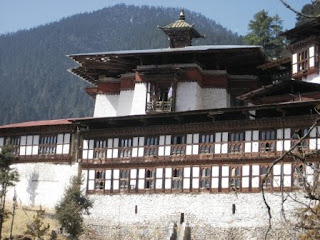Hawaii, Not Bhutan
The best place to view Bhutanese religious art is now Hawaii, not Bhutan. With the nearly simultaneous opening of the exhibit “Dragon’s Gift: the Sacred Art of Bhutan” at the Honolulu Academy of Arts, and the closing of lhakhangs (temples) to foreigners by the Department of Culture, non-Bhutanese will have better luck seeing thangkhas and statues in Honolulu than Thimphu.
The Department of Culture’s ruling came down about two weeks ago, summarily baring foreigners from entrance into religious buildings. As is customary here, there was no explanation for the ruling. Rumors about stolen artifacts, bomb scares, and desecration of temples abound, but no one really knows what prompted the policy change. Tour operators are frustrated, because most of Bhutan’s visitors are cultural tourists, and most of them wish to see Bhutan’s famous temples and monasteries. Though the policy change was just instituted, there is no grandfather clause, so tourists who booked and paid for their tours months ago will find their itineraries significantly altered.
Nonetheless, policies take time to spread outward from the Dzong and administrative office of Thimphu to the scattered locales they are intended to affect. A week after the ban (which I heard about from friends and read about in the newspaper, but of which I was never officially notified), I visited a Chari Gompa,

above Thimphu, with several Westerners and without the special permit that had been necessary to enter temples before the ban. We were warmly invited into the main shrine room. Feeling that we’d been lucky to enter at all, we prepared to leave. “Wait!,” the monk called to us, “There are several more shrines that you must visit!”

The Department of Culture’s ruling came down about two weeks ago, summarily baring foreigners from entrance into religious buildings. As is customary here, there was no explanation for the ruling. Rumors about stolen artifacts, bomb scares, and desecration of temples abound, but no one really knows what prompted the policy change. Tour operators are frustrated, because most of Bhutan’s visitors are cultural tourists, and most of them wish to see Bhutan’s famous temples and monasteries. Though the policy change was just instituted, there is no grandfather clause, so tourists who booked and paid for their tours months ago will find their itineraries significantly altered.
Nonetheless, policies take time to spread outward from the Dzong and administrative office of Thimphu to the scattered locales they are intended to affect. A week after the ban (which I heard about from friends and read about in the newspaper, but of which I was never officially notified), I visited a Chari Gompa,

above Thimphu, with several Westerners and without the special permit that had been necessary to enter temples before the ban. We were warmly invited into the main shrine room. Feeling that we’d been lucky to enter at all, we prepared to leave. “Wait!,” the monk called to us, “There are several more shrines that you must visit!”


Comments